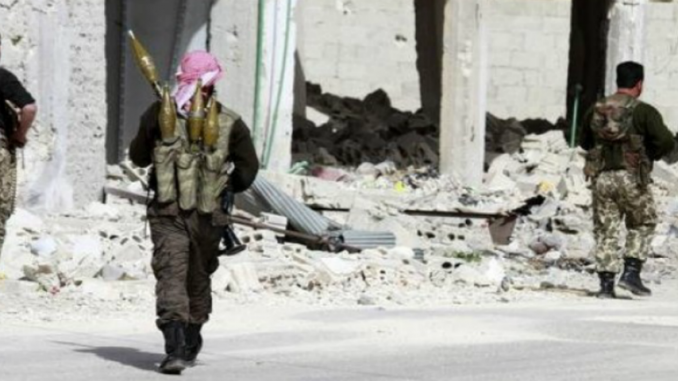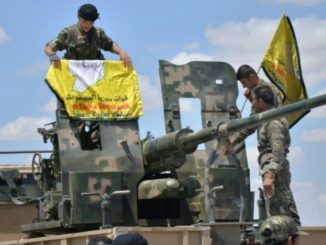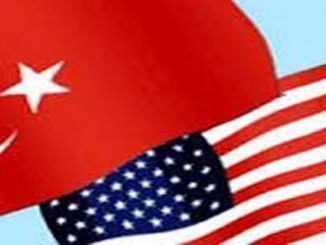
A total of 250 people including 80 fighters left Serghaya town on the outskirts of Damascus after long months of siege and bombardment by Assad regime and its allies, after many previous similar deals were made in rural Damascus making the rebels lose important parts of their stronghold in the area and giving signs that all of it may fall soon.
Rebel fighters and their families marched through Serghaya on Monday toward the line of buses waiting for them at the town’s border.
Shortly afternoon, a convoy of eight of the regime’s green buses filled with 200 passengers left Serghaya, located in the a-Zabadani mountains along the Lebanese border. The buses departed for opposition-held Idlib province.
Only a handful of Serghaya’s 20,000 residents chose to leave the town, fearing regime bombardment there and miserable conditions in Idlib displacement camps.
For almost two years, regime and Hezbollah forces have blockaded Serghaya, preventing the entry of medicine and fuel while cutting off access to farmland. However, Serghaya has mostly avoided regime shelling.
The town was controlled, until Monday, by a small contingent of Free Syrian Army fighters, as well as a local council.
For the regime, the settlement means the return of Serghaya and surrounding towns on the Lebanese border to government control. For town residents, the reconciliation brings hope that regime forces will release detained residents and lift their blockade of the town.
“The most important thing,” said the opposition coordinator, as rebels boarded the buses on Monday, “is that the regime doesn’t bombard Serghaya.”
Negotiations began two months ago, and the agreement was brokered by Russia.
The residents of Serghaya were threatened with regime bombardment if they did not reconcile and evacuate the rebel fighters. “We had two choices: we could face death by bombardment or we could reconcile. We accepted the settlement to keep the blood of Serghaya’s women and children from being spilled,” the coordinator said.
This evacuation is another chapter in Assad regime’s retrieving of the rebels’ held areas around Damascus.
Rebel groups retain a significant pocket of territory in Eastern Ghouta, an area of towns and farms east of the capital, but the enclave has been shrinking under army advances, intense bombing, and a prolonged siege.
Assad regime forces, helped by Russian air power and Iran-backed Shiite militias, has steadily ended armed opposition influence in the remaining pockets of resistance around the capital using a series of army offensives and evacuation agreements, after years of siege, starvation, and daily bombing.
Damascus describes the evacuation deals as “reconciliation” or “settlement agreements”, but rebels say they involve the forcible displacement of whole communities from opposition areas after years of siege and bombardment.
Changing the demographics of Damascus
The Ghouta area is composed of densely populated suburbs to the east and south of Damascus, part of the province of rural Damascus.
Ghouta is a primarily conservative Sunni region. Since early in the crisis, civilians in rebel-held Eastern Ghouta have almost entirely sided with the opposition to Syria’s government. The opposition has controlled much of Eastern Ghouta since 2012, partly cutting off Damascus from the countryside.
In several Syrian areas, lengthy government sieges have prompted rebels to agree to evacuation deals, leading activists to accuse Damascus of using “starve or surrender” tactics.
Some opposition groups have criticized these preconditions, calling them a major setback as Sunnis would be forced from their homes, further fracturing the country along sectarian lines.
They are seen as part of a pattern in which the government pushes out Sunni communities that have been living there for decades. In 2015, one of the first deals was made in Zabadani on the outskirts of the capital.
In 2015, one of the first deals was made in Zabadani on the outskirts of the capital, and its citizens were displaced to other areas.
since then, Assad regime forces have pushed harder to achieve similar “victories” in the opposition-held pockets around the capital.
The most important losses were in Darayya and Mouadamiya towns, which have been under crippling siege since 2012.
The towns became known as a center for the opposition from the start of the uprising against Assad, and later an important stronghold for the rebels in rural Damascus.
Darayya surrender agreement was signed at the end of August 2016. For four years, Darayya was under daily attacks by Assad regime. Assad regime forces tried to take the city on the ground while Assad regime’s air force bombed the city daily.
Weeks of intense bombardment, which activists say included napalm attacks, has finally overwhelmed the rebels and forces them to sign surrender, while the world stands watching the civilians being displaced.
“Darayya did not fail today,” George Sabra, one of the political opposition members, said. “It was the international community who failed, and failed the people of Darayya.”
“For four years Darayya was under siege and the international community did nothing,” said an activist. “Four years and the United Nations couldn’t provide any humanitarian aid, except once.”
After nearly a week, rebels in Mouadamiya town also signed a similar agreement, giving Assad regime full control over the area again.
“It wasn’t a negotiation or a conversation, it was a threat,” an activist said. “They basically told us: ‘Either surrender or we burn Mouadamiya.”
“A large portion of people don’t want to leave their homes because they don’t want the regime to forcefully change the demography of the area. They want to clear the area and put a different sect here. That’s their plan,” activists added.
The surrender is a disaster first and foremost for the people of Darayya and Mouadamiya. According to the surrender agreement, the town’s fighters will be transferred to Idlib province and the civilians to other parts of rural Damascus. It means the final end of their community, therefore, and another ethnic cleansing.
Russian and Iranian propaganda machine is hard at work alongside the Syrian regime’s, trying to frame these events as the “liberation” of a population described as hostages of Islamic terrorists.
The west didn’t act as it should, to prevent these tragic incidents. Many ceasefire agreements accompanied by peace talks meetings were organized to help find a solution to the crisis, but Assad regime and its backers breached every ceasefire and hindered every peace talks meeting without any pressure moves or real steps from the western powers.
All the west could do was condemnations, calls to stop, and finally acting as if they were not involved.



